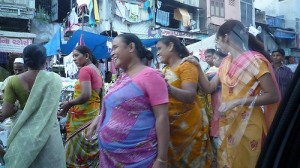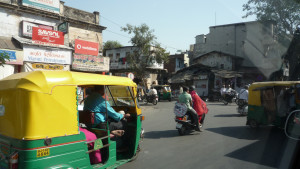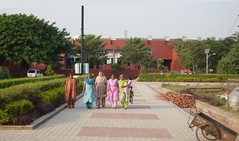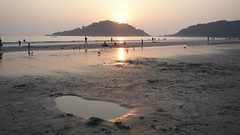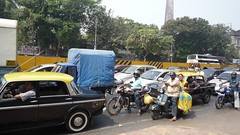Travel Bites
Short travel reviews of places I’ve been.
India
As the morning sun seeps in, I look out over the city. From the 15th floor of Le Meridien Ahmedabad, I see a vast slum below – ramshackle tin huts strewn with tires and tarpaulins, criss-crossed by an irregular grid of dusty lanes, where the impoverished residents wile away the long hot days. Three goats trot aimlessly across an open wasteland between the shacks and the river. At the river’s edge, a man squats, tissue paper in hand, and does his business over the edge of the steel-fortified riverbank.
Glancing back around my hotel room, I notice the dazzling silver platter where three rosy apples sit, perfectly reflected in the sunlight. Below the 24-inch HDTV, my drawer is still ajar. Each pair of freshly laundered socks is neatly folded in a cardboard sleeve, proudly bearing the hotel insignia.
I feel a sudden contempt for those who built this palace of Western opulence right next to a shanty town. Then a pang of guilt for enjoying the provided creature comforts like the king-size bed and the rooftop pool. But this initial culture shock subsides, and as the week progresses we discover another side to India. Saturday comes – our first day off – and we hire a car (driver included). We visit the spectacular Shaking Minarets, where devout worshippers remove their sandals and wash their feet in special troughs before entering the Mosque.
The many temples are islands of calm in a city of chaos. At Teen Darwala, a street market is in full swing. A swarm of shoppers engulf the road and we slow to a crawl. A woman in a bright green and pink sari walks alongside us, balancing an oversized bag of rice on her head. From a rickety trestle table, a moustachioed man sells pulses, spices and dried fish in assorted plastic tubs. Two young men in bold yellow and blue shirts cross in front of us, chatting. One has his arm draped over the other’s shoulder, an unfamiliar sight yet clearly platonic. A wizened grandmother leans out of her balcony overhead, hanging vibrant red, orange and purple clothes on a washing line. A gust of air delivers a tapestry of smells – exotic spices and the enticing aroma of barbecued meat, mixed with diesel fumes, human sweat and a faint odour of bad drains.
As we leave the centre, the crowds dissipate and vehicles take over. Tiny green and yellow motor-taxis rev past rainbow-painted trucks, darting like wasps from lane to lane. Horns beep all around us, short sharp bursts and chirps that say simply “I’m here,” not “Get out of my way.” Family-owned shops with hand-painted signs are replaced by four-storey office blocks with plastic facades of primary colours, like the handiwork of a child with a new Lego set. An astonishing array of vehicles passes by, from bicycle-powered flour trucks to donkey-pulled wooden carts. Most common is the family motorbike – father in front wearing the helmet, wife in the middle, sari flowing in the wind, and two children hanging on at the rear, grinning.
We come to a standstill on an old concrete bridge. A young girl of eight or nine stands by the roadside, naked but for a pair of red shorts, with a pail of water beside her. As I watch, she dips a shirt into the pail, wrings it out and lays it on the railing to dry. I am transfixed – but my lack of reaction disturbs me. Shouldn’t I be appalled at her destitution?
It’s not until a couple of days later that I understand. She wasn’t starving or malnourished. She wasn’t begging. She hadn’t given up on life. She was smiling and completely at ease. For her, it was routine. I realize that in India, people make the best of what they have – no obsessing over material wealth. Poverty and happiness, hand in hand.
That night, I look out from my hotel window with new eyes. I see that the “slum” below is anything but. The populace sit outside their homes on plastic chairs and sacks of rice, illuminated by bare bulbs strung like fairy lights between the rooftops and the overhanging trees. A fire crackles as they cook dinner. I can just make out the chatter of conversations and shrieks of delight from children at play.
I am a victim of my own prejudice. This is not a slum as I’d imagined it from African famine appeals and geography textbooks. These proud Indians are well-dressed, happy families with a roof above their heads. I’d imagined the streets of India piled with rubbish, people stricken with disease. Instead I find them filled with vibrant colours and smiling faces. As the sun sets, my eyes are opened.
Author’s Note: This was the second piece of writing from my non-fiction course. The assignment here was to write about a defining or pivotal moment in your life and write about it. At first I was a little stumped, the only pivotal moments I could think of were too personal to share – then I remembered how India had given me a totally new perspective on poverty – as well as encouraging me to question my prejudices. I’ve written about India before, so the challenge here was how to do justice to all those experiences in under 800 words. More on what I learnt in the comments.
Read More
The Road To Sepilok
A Short Travel Story
What follows is my entry into the 2008 Telegraph Travel Writing Competition. The brief was to write a short story in a maximum of 500 words about an adventurous travel experience. I’ll let it stand for itself, except to say that it happened while my wife and I were on honeymoon last summer. My wife is called Alex too – which you need to know while reading this or you will get confused!!
The Road To Sepilok
by Alex Bowyer
The fuel light had been flashing furiously for an hour. It was dark now. In 100 miles we’d seen only two petrol stations; our anxiety grew into panic when we found a third one deserted.
Driving across Malaysian Borneo was always going to be ambitious, but we really wanted to see orang-utans in the wild. We hadn’t anticipated this kind of trouble.
“If we run out, who could we call?” I wondered aloud, “I bet there’s no AA here.”
“No,” sighed Alex.
At last the endless palm plantations receded. We’d reached the outskirts of Sandakan.
“Can you tell how far it is?” Alex asked. Her voice was strained.
I checked. “No.” Useless map.
Minutes passed. We drove on.
“Hang on!” I yelled. “I saw a sign.” We must be close!
She pulled over.
“OK, you go and check. I’ll turn around.”
I walked back to the roundabout and crossed the road carefully, invisible in the darkness. Cicadas chirruped loudly in the dense jungle all around. I reached the signpost. It read LABUK B&B – 600 METRES, with a big arrow. I smiled. What a relief! I bounded back, eager to share the good news.
Getting closer, I froze. Four Malaysian youths surrounded the car. Shit. I ran, my heart pounding. Shouldn’t have left her.
Read MoreIndia Travelogues
In case you missed it, here is my journey through India recounted in ten blog posts:
- India 1: Losing my business class virginity (with a backpack!)
- India 2: First Impressions of India
- India 3: How to get a drink in Ahmedabad
- India 4: Look at the strange cow-eating white men!
- India 5: Adalaj Wav Stepwell
- India 6: A night out in Mumbai, local-style
- India 7: The Mumbai Milk Scam
- India 8: Rules of the Road: Ahmedabad vs Mumbai
- India 9: Goa Goan Gone
- India 10: A feast for the senses; a land at peace
And here are some photos from my trip.
Read More
A feast for the senses; a land at peace
India 10: Reflections on India
So, my three week trip to India is nearing its end. Tomorrow I fly back to Mumbai and on Wednesday back home. As I reflect on my time in India my feelings are overwhelmingly positive. From day one, India has blown away all expectations. I have to confess I was pretty prejudiced about India. I imagined a disease ridden place with rubbish and bodies in the streets and destitute people all around. I couldn’t have been more wrong. Yes there is more rubbish than you would see elsewhere – but not in the streets, the people are very proud and streets and highways are regularly swept clean. You have to look hard to see the rubbish – down back alleys and at the edges of towns. There are no bodies in the street either. That seems to be pure myth. The only thing we did see occasionally is sarcophaguses of mummified religious leaders by the roadside, as sort of shrines.
The most significant thing that strikes me about India is the colours.
Read MoreGoa Goan Gone..
India 9: Goa – Paradise lost?
After a successful week’s work in Mumbai, Steve headed home to the UK, and I took advantage of the paid flight to India to take a week’s holiday.. beach time in Goa! I’d heard mixed things about Goa – from people saying that it wasn’t “the real India” and best avoided, to people saying it’s total paradise.
Well the good news is that nature-wise it’s beautiful. On the way from the airport we passed fields, palm & rubber plantations, rainforest. Goa is a state on the west coast of India with 63 miles of west-facing coastline – which means beautiful beaches and amazing sunsets every night. I stayed in Palolem Beach in the far south of Goa – which is a sort of alternative/backpacker place like Byron Bay in Australia or Ko Phi Phi in Thailand. I’ve always preferred the laid back alternative scene than just going to get pissed in the sun somewhere! First impressions were great, a long bay with golden sands and overhanging palm trees. Not complete paradise, the sand is not as clean as it could be, and there just a few too many beach-front huts, bars and restaurants – but it comes pretty close!
I stayed in a very nice beach hut (actually a couple of different ones – the tourist season is just starting up here so it’s starting to fill up, I had to move after the first night!)
After a few days I decided it was time to do some sightseeing, so I hired a car with driver for the day (about 25 GBP) and saw Panjim, Old Goa and Fort Aguada, all of which are fine remnants of the Portugese era which only ended in 1961.
Read MoreRules of the road: Ahmedabad vs Mumbai
India 8: Indian driving styles
I’ve never seen traffic anything like the traffic in Ahmedabad. Not because it’s chaotic, but because they seem to have some set of unwritten rules that actually produce order from the chaos such that people rarely crash into one another. In Ahmedabad probably only a quarter of the vehicles are cars as we’d know them. Most are auto-rickshaws or motorbikes, and the rest are either tiny trucks shorter and narrower than Western cars, or a variety of thrown-together carts pulled by camel, cow, three-wheeled bicycle or even pulled by hand. There is no such thing as lane discipline. Since the average vehicle size is so much smaller, roads are typically filled four or five vehicles across. People cut into whatever gaps are available, bipping their horns as they do so to say “watch out, I’ve got this space”. I never heard anyone beeping out of frustration. The only rule I could discern is that like at sea, smaller vehicles give way to bigger vehicles.
The amazing thing is that there is no road rage to speak of, and while the vehicles seem to all look a little battered and dented, I only saw one bump the whole time we were there. The thing that stands out in my mind is that people seemed to just expect other people to cut them up, and accepted it graciously. I wondered what it would be like if we had such a system in the West – would there be fewer accidents? As we got out of the city I realised that one of the reasons it worked is that the traffic is fairly slow, so people have more time to react. Once you get out of the centre with vehicles at speed it gets a little more hairy. But still, it was very interesting to observe.
Mumbai, on the other hand was a completely different kettle of fish.
Read More



